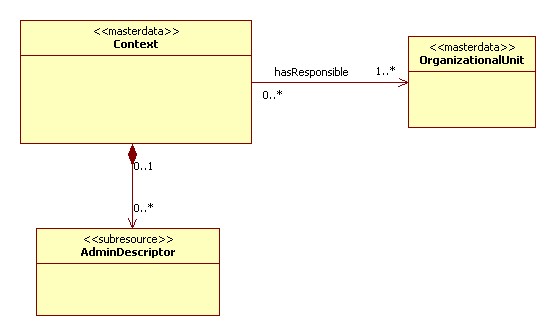Difference between revisions of "ESciDoc Logical Data Model/Context"
| Line 8: | Line 8: | ||
Each context may have associated sub-resources named admin descriptors. An '''Admin Descriptor''' can be created to define various settings that may be used by end-user applications (solutions) to precise the e.g. workflows, validation mechanisms, metadata profiles etc. The content and the structure of the admin descriptors is not pre-defined i.e. it may be defined based on specific user requirements. | Each context may have associated sub-resources named admin descriptors. An '''Admin Descriptor''' can be created to define various settings that may be used by end-user applications (solutions) to precise the e.g. workflows, validation mechanisms, metadata profiles etc. The content and the structure of the admin descriptors is not pre-defined i.e. it may be defined based on specific user requirements. | ||
Context are entities that are mostly referenced resources in an eSciDoc repository: | |||
*'''scope''': each content resource (being [[ESciDoc_Logical_Data_Model/Item|Item]] or [[ESciDoc_Logical_Data_Model/Container|Container]]) is managed within one single context | |||
*'''authorization''': as being an administrative unit for the management of content, context objects play an important role in the definition of authorization mechanisms. Most of the authorization policies can be defined on a context level such as: | |||
**who are users who may deposit content in the repository (Depositors, context level only) | |||
**who are users who may curate the content in the repository (Moderators, context level only) | |||
==UML Diagram== | ==UML Diagram== | ||
Revision as of 16:18, 5 October 2009
Introduction[edit]
This page provides general overview on the Context resources within the eSciDoc repository. General introduction available at eSciDoc Logical Data Model page.
Model description[edit]
A Context represents an administrative unit for the management of content resources in eSciDoc repository. It is related to an organizational unit, to point which organization or institution is responsible for management of content in that context.
Each context may have associated sub-resources named admin descriptors. An Admin Descriptor can be created to define various settings that may be used by end-user applications (solutions) to precise the e.g. workflows, validation mechanisms, metadata profiles etc. The content and the structure of the admin descriptors is not pre-defined i.e. it may be defined based on specific user requirements.
Context are entities that are mostly referenced resources in an eSciDoc repository:
- scope: each content resource (being Item or Container) is managed within one single context
- authorization: as being an administrative unit for the management of content, context objects play an important role in the definition of authorization mechanisms. Most of the authorization policies can be defined on a context level such as:
- who are users who may deposit content in the repository (Depositors, context level only)
- who are users who may curate the content in the repository (Moderators, context level only)
UML Diagram[edit]
- For simplicity reasons properties of the objects are not represented on the diagram. Properties are managed by the escidoc repository itself and may change during time. For more information on the properties and ther usage please check the documentation available at eSciDoc Organizational Units Service.
Examples[edit]
Top level organizational unit[edit]
A top level is an organizational unit that has no parent organizational units associated. It may have any number of child organizational units associated.
Child organizational unit[edit]
A child organizational unit has at least one parent organizational unit associated. It may have any number of child organizational units associated.
